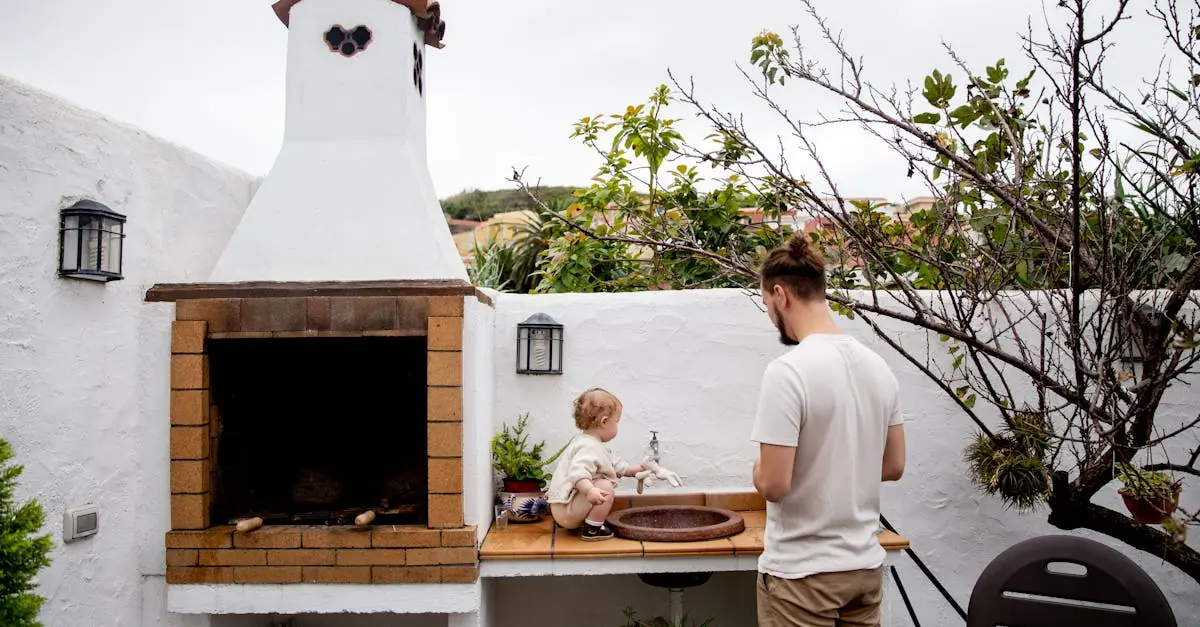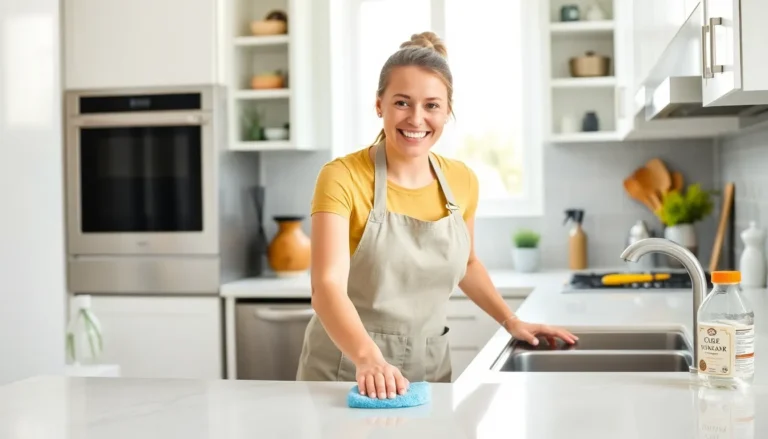Imagine hosting summer barbecues in a stunning outdoor kitchen that doesn’t just impress your friends but also makes you feel like a culinary rock star. A DIY brick outdoor kitchen can transform your backyard into a gourmet haven, and the best part? You don’t need to be a masonry wizard to pull it off. With a bit of creativity and some elbow grease, anyone can craft a space that’s both functional and fabulous.
Picture this: you’re flipping burgers while sipping on a cold drink, and your guests are marveling at your craftsmanship. Who knew you had such hidden talents? Building a brick outdoor kitchen isn’t just about cooking; it’s about creating memories, enjoying the fresh air, and maybe even showing off a little. Let’s dive into the world of DIY brick outdoor kitchens and explore how you can elevate your outdoor living experience without breaking the bank.
Table of Contents
ToggleOverview of DIY Brick Outdoor Kitchen
Creating a DIY brick outdoor kitchen presents an opportunity for homeowners to enhance their outdoor living spaces. This project combines functionality and aesthetics, turning backyards into culinary havens. Building an outdoor kitchen doesn’t require advanced skills; basic masonry techniques suffice to achieve great results.
A brick outdoor kitchen features various elements, including countertops, grills, and storage. These components can be customized to meet specific needs. Considering layout and design is crucial for maximizing space and utility.
Selecting materials is an essential part of the process. Brick is durable, weather-resistant, and complements various home styles. A wide range of accessories also elevates the outdoor cooking experience, such as sinks, refrigerators, and even pizza ovens.
Incorporating features like seating areas creates a welcoming environment for gatherings. Entertaining with family and friends becomes easier when an outdoor kitchen is available. Moreover, this setup encourages a seamless flow between indoor and outdoor areas.
Planning involves various steps, including budgeting, design drafting, and material sourcing. Setting a clear budget helps manage costs effectively. Additionally, researching local regulations ensures compliance with any guidelines for outdoor installations.
The benefits of a DIY brick outdoor kitchen are numerous. It increases property value, provides a space for creativity, and promotes a healthier lifestyle through home-cooked meals. A well-designed outdoor kitchen caters to personal cooking preferences, making it a rewarding investment for any homeowner.
Planning Your DIY Brick Outdoor Kitchen
Planning a DIY brick outdoor kitchen involves careful consideration of location, layout, and design. It’s essential to create a space that offers functionality and suits personal preferences.
Selecting the Right Location
Choose a location that’s easily accessible from the house. A spot near dining areas enhances convenience for serving food and beverages. Look for a level surface to create a stable foundation. Consider factors like sunlight, protection from wind, and proximity to utilities like gas lines and water sources. These elements ensure safety and efficiency during cooking. Space permitting, keep the kitchen at least 10 to 15 feet away from any flammable structures. This distance minimizes fire hazards and ensures compliance with safety regulations.
Designing Your Kitchen Layout
Begin by envisioning the kitchen’s flow and functionality. Create designated zones for cooking, food prep, and dining. Placing the grill, countertop, and seating within close proximity streamlines the cooking experience. Optimize counter space by utilizing L-shaped or U-shaped designs, which facilitate movement while preparing meals. Include ample storage for utensils, cookware, and supplies, maximizing available space. Visualize the arrangement by sketching or using design software to refine ideas, ensuring an efficient design before construction begins. Incorporating features like a pizza oven or built-in bar can elevate the experience, making the kitchen a true outdoor kitchen hub.
Materials Needed for Your DIY Project
Gathering the right materials is essential. A well-chosen assortment leads to a successful DIY brick outdoor kitchen.
Types of Bricks and Mortar
Bricks come in various types suited for outdoor use. Fire bricks withstand high temperatures, making them ideal for pizza ovens. Clay bricks offer a traditional appearance and durability. Concrete bricks are cost-effective and easy to work with. Selecting high-quality mortar ensures strong, lasting bonds. Consider using a sand-mix mortar that allows for flexibility and breathability, critical in outdoor environments. Always check local building codes for material specifications to guarantee compliance.
Essential Tools and Equipment
Essential tools make the building process streamlined. A masonry trowel helps spread mortar evenly across bricks. A level ensures that surfaces stay straight and even. Utilizing a brick hammer facilitates precise cuts and adjustments. Tape measures and chalk lines establish accurate measurements for layout. Mixing equipment such as a wheelbarrow is necessary for combining mortar. Safety goggles and gloves protect against debris and injuries. Having these tools on hand not only aids efficiency but also contributes to a professional-quality finish.
Step-by-Step Guide to Building Your Outdoor Kitchen
Building a DIY brick outdoor kitchen involves several key steps. Follow this guide to ensure a successful project.
Preparing the Site
Start by selecting a level area in the yard. This space should be easily accessible from the home and near dining areas. Clear any vegetation, rocks, or debris for a clean working surface. Mark the kitchen layout using stakes and string to visualize dimensions. Ensure that local regulations about patio or kitchen structures are followed. Consider drainage and wind direction when finalizing the placement.
Constructing the Brick Structure
Lay a solid foundation to support the weight of the structure. Excavate the area to a depth of about 6 inches, adding gravel for drainage. Begin by mixing high-quality mortar, then lay the first course of bricks. Use a level to check alignment and spacing. As each layer is added, taper the joints for stability. Incorporate features like a grill or pizza oven into the design at the appropriate height. Allow the mortar to set before continuing to the next courses.
Installing Countertops and Appliances
Select durable materials for countertops, such as granite or concrete for longevity. Construct frames to support the countertops, ensuring they align with the brick structure. Secure appliances, like grills or sinks, into their designated spaces, double-checking plumbing and electrical connections. Finishing touches may include installing backsplashes or decorative elements. Seal countertops to protect against weather elements and maintain aesthetics. Make sure everything is functional and accessible for ease of use.
Finishing Touches and Decoration
Incorporating final details enhances the charm of a DIY brick outdoor kitchen. Attention to furnishings and lighting creates a cohesive and inviting space.
Choosing Outdoor Furnishings
Selecting outdoor furnishings involves matching styles and functionality. Durable materials, such as weather-resistant wicker or aluminum, offer long-lasting comfort. Consider comfortable seating options like cushioned chairs and benches that encourage relaxation. Tables should be at an appropriate height for dining and socializing. Adding accessories like colorful cushions or outdoor rugs can bring vibrancy to the space. Personal touches significantly enrich the atmosphere, showcasing individual preferences. Arrange seating to facilitate conversation and complement the cooking area, ensuring a smooth flow for entertaining guests.
Lighting and Appliance Considerations
Effective lighting transforms an outdoor kitchen into an inviting area during evening gatherings. Use ambient lighting, such as string lights or lanterns, to create a warm ambiance. Installing task lighting, including spotlights over cooking zones, enhances visibility while cooking. Consider energy-efficient LED options for longevity and lower energy costs. Appliancing choices should reflect the intended cooking style, including grills, refrigerators, or smokers. Selecting high-quality appliances ensures optimal performance for outdoor cooking needs. Each element contributes to functionality and style, allowing for enjoyable cooking and dining experiences.
A DIY brick outdoor kitchen transforms any backyard into a culinary haven. With thoughtful planning and the right materials anyone can create a space that enhances outdoor living and entertains guests. The combination of functionality and style not only elevates cooking experiences but also adds significant value to a home.
By incorporating personal touches and durable furnishings the outdoor kitchen becomes a welcoming retreat for family and friends. As summer gatherings become more memorable the joy of cooking outdoors fosters a healthier lifestyle. This project is more than just construction; it’s about creating lasting memories and enjoying the beauty of outdoor cooking. Embrace the opportunity to build a space that reflects individual tastes and elevates outdoor dining experiences.




